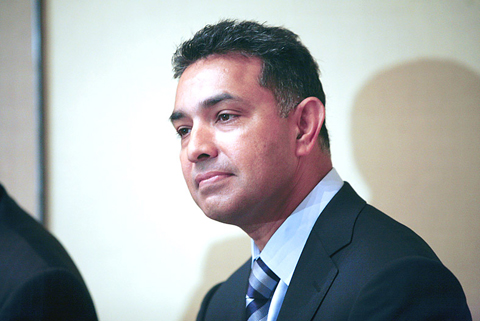Sanjay Jha’s honeymoon as co-chief executive at Motorola lasted just a few minutes into his first meeting with employees last year.
“Why should we trust you?” one employee blurted.
The frustration was understandable. Motorola, which pioneered cellphones and built such consumer favorites as the StarTac and the Razr, had not had a hit phone in years, and a succession of leaders could not find one.

PHOTO: BLOOMBERG
Jha, 46, an engineer who worked his way up at Qualcomm from a chip designer to the No. 3 executive, answered the challenge, saying employees should not take him on faith but watch what he did.
Jha recalled in a recent interview that he had hoped, at a minimum, that his talk “gave the team general comfort I wasn’t a huckster.”
He knew he had to act fast to slash costs and prune dozens of phones that were based on dead-end technology that simply were not profitable. That made the last few months of 2008 a financial disaster — losses doubled as sales fell by a third.
Jha also knew he had only a year to deliver new handsets that could go head to head with Apple’s iPhone if he had any hope of retaining the trust of Motorola’s employees, investors and customers — not to mention its board, which had lured him with an enormous grant of stock and options.
“If I didn’t have smartphones in the market for Christmas of [20]09, this business wouldn’t have a runway,” he said.
Jha does not have Motorola flying again, but he at least has it poised for a takeoff. On Wednesday, Verizon Wireless introduced Motorola’s new Droid smartphone, which is nearly as thin as an iPhone but with a bigger screen and a slide-out keyboard. T-Mobile has started selling another Motorola smartphone called the Cliq.
“Motorola is a different place than it was a year ago,” said Paul Cole, T-Mobile’s vice president for product development. “Sanjay has done a spectacular job.”
Looking back, Jha said that Motorola was in worse shape than he knew when he took the job, largely because of a dysfunctional management culture that missed the shift in consumer preferences from phones designed primarily for talking to those that do nearly everything a computer can do. The company’s engineering talent, which had once developed great phones, remained intact, he said.
As luck would have it, one of those engineers, Rick Osterloh, grabbed Jha just as he stepped off the stage at that first town meeting in August last year. Jha had mentioned Google’s Android operating system for smartphones. Osterloh rushed the stage to tell him he was working on an Android phone in Motorola’s Silicon Valley outpost that would bring together text messages, e-mail and social-network updates.
By the end of that week, Osterloh was sitting on the corporate jet, flying with Jha back to California and explaining the Android concept in detail. A few days later, the top dozen members of Osterloh’s group assembled in a conference in Motorola’s office in Sunnyvale, California, to review the work done so far. The four-hour meeting was scheduled for 6pm, a shock for Motorola’s 9-to-5 culture. And Jha had not only asked for the PowerPoint of the presentation in advance, he had read all 100 slides and asked such detailed questions that the presenters had had to produce 20 more slides.
“He was able to understand what we were doing at such a detailed level. I was very impressed,” Osterloh said.
Jha was just as impressed with Osterloh’s unit.
“Very quickly, I figured out they knew how to write software,” Jha said. “It felt like a team that would execute.”
In the weeks after, as Jha scrutinized Motorola’s other product groups, he often had the opposite reaction. At another meeting that ran late into the night, he discovered that the group making phones with Nokia’s Symbian operating system was staffed almost entirely by outside contractors. The entire project appeared to lack coordination and it was constantly months late in delivering phones.
Jha soon decided to axe the entire Symbian product line as well as phones using several other operating systems. He wanted to simplify product development to standardize on one or two core systems. It came down to a Microsoft Windows mobile operating system and Android. When Microsoft said that a crucial release of its mobile operating system would be delayed, Jha gave Microsoft the stiff arm and bet on Android.
Last fall, Jha received an e-mail from Verizon, asking for ideas for a “long ball play for the fourth quarter” of this year, Jha said. That meant a smartphone that could take on the iPhone. He flew to the carrier’s headquarters in Basking Ridge, New Jersey, bringing with him models of several of the company’s latest designs. Verizon executives seemed partial to one thin, angular handset that had been designed in London. Even without a firm order, Jha immediately assigned Iqbal Arshad, who had been the project manager for the Verizon version of the Razr, to transform the mockup into a smartphone Verizon could sell a year later.
“Sanjay said, ‘Burn the ships and focus on Android,’” Arshad recalled.
That meant rearranging the existing, tightly packed interior to accommodate the larger chips needed to connect to Verizon’s network. Meanwhile the phone’s overall design needed to be exciting enough to go head-to-head with the iPhone.
They found a way to fit a slide-out keyboard into a phone that was only 1.5mm thicker than the iPhone. And they used a 3.7-inch touchscreen, noticeably bigger than the 3.5-inch screen on the iPhone. To take advantage of the higher resolution of that screen, Motorola, working with Google, developed new software that would support high-definition video and 3-D graphics.
Analysts at the launch on Wednesday said that the Droid, which will be backed by the biggest ad campaign by Verizon Wireless and sell for US$199 this week, is a crucial milestone in Motorola’s recovery.
“To be able to come out with a sexy flagship device that is getting so much promotion from Verizon and really shows off their hardware skills — it looks like their bet on Android is going to pay off,” said Avi Greengart, research director for consumer devices at Current Analysis. “If they hadn’t delivered something like this, they’d be out of business.”

Authorities have detained three former Taiwan Semiconductor Manufacturing Co (TMSC, 台積電) employees on suspicion of compromising classified technology used in making 2-nanometer chips, the Taiwan High Prosecutors’ Office said yesterday. Prosecutors are holding a former TSMC engineer surnamed Chen (陳) and two recently sacked TSMC engineers, including one person surnamed Wu (吳) in detention with restricted communication, following an investigation launched on July 25, a statement said. The announcement came a day after Nikkei Asia reported on the technology theft in an exclusive story, saying TSMC had fired two workers for contravening data rules on advanced chipmaking technology. Two-nanometer wafers are the most

NEW GEAR: On top of the new Tien Kung IV air defense missiles, the military is expected to place orders for a new combat vehicle next year for delivery in 2028 Mass production of Tien Kung IV (Sky Bow IV) missiles is expected to start next year, with plans to order 122 pods, the Ministry of National Defense’s (MND) latest list of regulated military material showed. The document said that the armed forces would obtain 46 pods of the air defense missiles next year and 76 pods the year after that. The Tien Kung IV is designed to intercept cruise missiles and ballistic missiles to an altitude of 70km, compared with the 60km maximum altitude achieved by the Missile Segment Enhancement variant of PAC-3 systems. A defense source said yesterday that the number of

A bipartisan group of US representatives have introduced a draft US-Taiwan Defense Innovation Partnership bill, aimed at accelerating defense technology collaboration between Taiwan and the US in response to ongoing aggression by the Chinese Communist Party (CCP). The bill was introduced by US representatives Zach Nunn and Jill Tokuda, with US House Select Committee on the Chinese Communist Party Chairman John Moolenaar and US Representative Ashley Hinson joining as original cosponsors, a news release issued by Tokuda’s office on Thursday said. The draft bill “directs the US Department of Defense to work directly with Taiwan’s Ministry of National Defense through their respective

Tsunami waves were possible in three areas of Kamchatka in Russia’s Far East, the Russian Ministry for Emergency Services said yesterday after a magnitude 7.0 earthquake hit the nearby Kuril Islands. “The expected wave heights are low, but you must still move away from the shore,” the ministry said on the Telegram messaging app, after the latest seismic activity in the area. However, the Pacific Tsunami Warning System in Hawaii said there was no tsunami warning after the quake. The Russian tsunami alert was later canceled. Overnight, the Krasheninnikov volcano in Kamchatka erupted for the first time in 600 years, Russia’s RIA